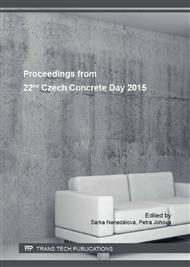p.179
p.185
p.191
p.197
p.203
p.209
p.215
p.221
p.227
Experimental Analysis of Slender Concrete Columns at the Loss of Stability
Abstract:
The use of non-linear methods for design of slender concrete columns by European standards. For the verification of non-linear design methods it is important to compare their results with results of experiments. Within the applied research of the Faculty of Civil Engineering at Slovak University of Technology in Bratislava in cooperation with the company ZIPP Bratislava LTD the experimental verification of the slender reinforced concrete columns was realized. In the paper the authors present the preparation and process one of three series of slender reinforced concrete columns, which were made to verify the reliability of various design methods. Columns of planned second series were designed from high performance concrete C100/115, but the material tests showed that the strength class of concrete was C70/85. The columns, subjected to axial force and bending moment were designed to fail due to loss of stability before the resistance of the critical cross-section is reached. The expected compressive strain in concrete was 1,5 ‰.
Info:
Periodical:
Pages:
203-208
Citation:
Online since:
April 2016
Authors:
Keywords:
Price:
Сopyright:
© 2016 Trans Tech Publications Ltd. All Rights Reserved
Share:
Citation:


